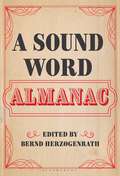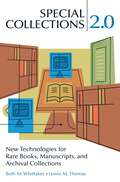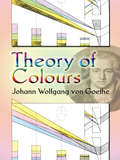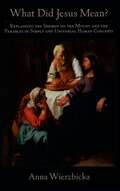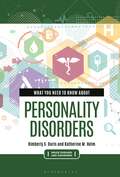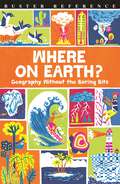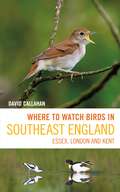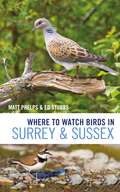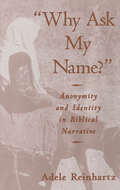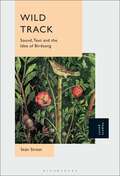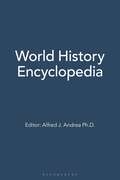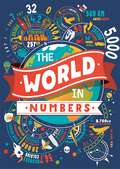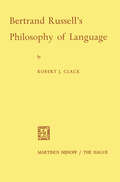- Table View
- List View
“Something that I read in a book”: vol. 2: Yeats Writings (Clemson University Press)
by Wayne ChapmanThis book is a resource to enable scholars and students in Yeats studies to explore the materials in his library, which, together with his unpublished papers and manuscripts, forms part of the writer’s archive in the National Library. Continuing from the first volume (Reading Notes), Volume II describes copies of books he wrote or edited solely in his name and subsequently revised or marked for other purposes, on occasion aided by his wife and others.This book could not have been written without the generous participation of the Yeats family over many years. Their legacy, now entrusted to the National Library, is robust and endless in potential. This book is about individual cases but also the building of an oeuvre.
“Something that I read in a book”: vol. 1: Reading Notes (Clemson University Press)
by Wayne ChapmanThis book is a resource to enable scholars and students in Yeats studies to explore the materials in his library, which, together with his unpublished papers and manuscripts, forms part of the writer’s archive in the National Library. Generally, this first volume describes the evidence that he and his wife, George, left in books by other authors, including extensive indications of close reading and thinking on a surprising range of subjects. This book could not have been written without the generous participation of the Yeats family over many years. Their legacy, now entrusted to the National Library, is robust and endless in potential. This book is about individual cases but also the building of an oeuvre. In short, this book enriches our understanding of Yeats’s accomplishment as a writer in over fifty years of creative effort and nearly seventy-four years of abundant life.
A Sound Word Almanac
This almanac of sound words important to artists and scholars highlights words that expand the way we speak (and write) about sonic experiences.Why write about sound, and how? If sonic philosophy is the attempt "to think about sound by philosophical means," then a metaphilosophical debate appears almost immediately on the horizon: What is called for is an understanding about sound and language, but also about the preconditions of musical understanding. What is at stake is the question of language and sound, as well as expanding how we speak about sonic experience.This almanac tackles these questions from artistic, experimental and personal perspectives. An assemblage of nearly 70 practitioners and theoreticians, artists and scholars offer their favorite 'sound word.' These sound words are onomatopoetical, mythological, practical; words of personal importance to the artists and their craft; words from their memory, related to sound. Many entries are not in English – some are untranslatable – and all are accompanied by a personal, explanatory, poetic entry. These are words that have the potential to change our perspective on listening-musicking-thinking.
South Carolina Driver’s Manual
by South Carolina Department of Motor VehiclesSouth Carolina Driver’s Manual
Special Collections 2.0: New Technologies for Rare Books, Manuscripts, and Archival Collections
by Beth M. Whittaker Lynne M. ThomasA critical examination of Web 2.0 tools used in special collections, archives, and museums, with an emphasis on using interactive technology to create and preserve content.Based on surveys and firsthand research across the archivist's profession, Special Collections 2.0: New Technologies for Rare Books, Manuscripts, and Archival Collections offers essential advice and practical ideas for creating, collecting, and preserving born-digital materials for optimal long-term access—using the best of what the new Web has to offer. Special Collections 2.0 surveys the web's new options for interconnectivity and interactivity tool by tool, exploring the benefits and shortcomings of applying each to the special collection and archives profession. It combines expert analysis of the pros and cons of Web 2.0 with numerous reports of how wikis, blogs, photosharing, social networks, and more are already being put to work in this essential field. Creators, researchers, and caretakers of the historic record—even those anxious about using the Internet—will understand the best ways to put Web 2.0 to work in the service of our cultural heritage.
The Subject Bibliography of the Social Sciences and Humanities: International Series of Monographs in Library and Information Science
by Barbara M. HaleInternational Series of Monographs in Library and Information Science, Volume 12: The Subject Bibliography of the Social Sciences and Humanities focuses on subject bibliographies of the humanities and social sciences. The manuscript first outlines the development of subject bibliography in the 16th up to 20th centuries, including developments in subject bibliography of social sciences and humanities and theory of bibliography. The book then discusses subject bibliography and flow of information. Topics include information storage and retrieval, scholarly communications, and other library tools. The text surveys the alphabetical and chronological arrangements of subject bibliographies, including the arrangement of selected bibliographies. Current and retrospective unannotated bibliographies and indexes; current and retrospective bibliographical reviews; and grading and abstracts are underscored. The book is a vital reference for readers wanting to explore humanities and social sciences.
Teilhard Lexicon: Understanding the Language, Terminology and Vision of the Writings of Pierre Teilhard de Chardin
by Sion CowellWritten to enable researchers and students to better understand the specialised language of Teilhard's transdisciplinary approach, which he found himself compelled to develop as a means of expressing that extraordinary vision of a universe in process of convergence towards a cosmic centre of unity he identifies with the Cosmic Christ. All quotations in the Lexicon have been sourced from the French originals. The work includes a full bibliography of Teilhard's works in French and English. 2005 marks the 50th anniversary of Teilhard's death. Several conferences are planned to mark this anniversary.
Theory of Colours: Translated From The German, With Notes (Dover Fine Art, History Of Art Series)
by Johann Wolfgang Goethe Charles L. EastlakeThe wavelength theory of light and color had been firmly established by the time the great German poet published his Theory of Colours in 1810. Nevertheless, Goethe believed that the theory derived from a fundamental error, in which an incidental result was mistaken for a elemental principle. Far from affecting a knowledge of physics, he maintained that such a background would inhibit understanding. The conclusions Goethe draws here rest entirely upon his personal observations.This volume does not have to be studied to be appreciated. The author's subjective theory of colors permits him to speak persuasively of color harmony and aesthetics. These notions may evoke a positive response on their merits, but even among those who regard them as pure fantasy, the grace and style of Goethe's exposition provide abundant rewards. Although his scientific reasoning on this subject has long since been dismissed, modern readers continue to appreciate the beauty and sweep of Goethe's conjectures regarding the connection between color and philosophical ideas. In addition, he offers insights into early 19th-century beliefs and modes of thought as well as a taste of European life during the Enlightenment.
Top Ten Global Justice Law Review Articles 2007 (Terrorism: Documents of International and Local Control, Second Series)
by Amos N GuioraTop Ten Global Justice Law Review Articles 2007 is a thorough and accessible review of the most salient, the most controversial, and the most illuminating essays on security law in the previous calendar year. In this edition, Professor Amos Guiora presents the ten most vital and pertinent law review articles from 2007 written by both scholars who have already gained international prominence as experts in security law as well as emerging voices in the security-law debate. These articles deal with issues of terrorism, security law, and the preservation of civil liberties in the post-9/11 world. The chosen selections derive not just from the high quality and expertise of the articles' authors, but equally from the wide diversity of legal issues addressed by those authors. Guiora combines the expertise of scholars from such accredited institutions as Harvard, Stanford, the U.S Military Academy and the U.S. Department of Defense to provide a valuable resource for scholars and experts researching this important subject area. This annual review provides researchers with more than just an authoritative discussion on the most prominent security debates of the day; it also educates researchers on new issues that have received far too little attention in the press and in academia. These expert scholars and leaders tackle and give voice to these issues that range from cyberterror to detention of suspected terrorists to France's tightening of its civil liberties policy to new restrictions on religious philanthropy and beyond. Together, the vast knowledge and independent viewpoints represented by these ten authors make this volume, of what will be an annual review within the Terrorism, 2nd Series, a valuable resource for individuals new to the realm of security law and for advanced researchers with a sophisticated understanding of the field. Top Ten Global Justice Law Review Articles 2007 serves as a one-stop guidebook on how both the U.S. and the world generally are currently waging the war on terror.
What Did Jesus Mean?: Explaining The Sermon On The Mount And The Parables In Simple And Universal Human Concepts
by Anna WierzbickaWhat to Draw and How to Draw It
by E G LutzLearn how to draw, with a masterclass from the man who inspired Walt Disney.Credited with being the inspiration for Walt Disney to pick up a pencil and pursue a career in animation, E G Lutz's method of drawing complex illustrations in gradual, simplified stages paved the way for many of the artists and illustrators who followed him.* Learn how to draw a delightful range of subjects, from animals and people to toys, buildings and landscapes.* Pictures are broken down into simple shapes and lines, which are then built up, with the aid of clear step-by-step instructions, into beautiful drawings.* Simple to follow, yet using principles seen in sophisticated artworks and animations today, this guide can help budding artists of all ages to develop their skills.Nostalgic yet timeless, this historically and culturally important book has inspired so many adults and children to draw and can help you too to discover the delights of creating your own artwork.
What You Need to Know about Personality Disorders (Inside Diseases and Disorders)
by Katherine M. Helm Kimberly S. DurisThis volume provides readers with all the information they need to know about personality disorders, including how to assess, treat, manage, and diagnose the varying signs and symptoms of the 10 different personality disorders currently recognized.Having a personality disorder is different than having personality quirks. Personality quirks or eccentricities are considered normal; however, when certain dominant personality traits interfere with healthy psychological functioning, a personality disorder might be the cause.This next installment in Greenwood's Inside Diseases and Disorders series provides a complete overview of the 10 currently recognized personality disorders, as well as the myriad signs and symptoms that may lead to a diagnosis. Using the most recent scholarship and case studies, this volume aims to bring clarity to the topic of personality disorders, covering a wide range of topics from the history of assessing personality disorders to the ways in which a personality disorder may affect the family and friends of the patient.
Where On Earth?: Geography Without the Boring Bits
by James DoyleWhere on Earth? is jam-packed with all of geography's greatest hits, with all the boring bits taken out. From how to make a raindrops to cool ways to remember the world's wonderful waterfalls, longest rivers and most desolate deserts - plus all the countries and continents in which these fantastic features are found. The perfect learning companion to help all school children get to grips with discovering the world around them.
Where to Watch Birds in Southeast England: Essex, London and Kent (Where to Watch Birds)
by David CallahanThe definitive site guide to a surprisingly bird-rich corner of England – Kent, Essex and the Greater London area.From the deep forests of Kent to the low-lying mudflats, beaches and saltmarshes of the Greater Thames Estuary, this ecologically rich area of England attracts vast numbers of wildfowl and waders. The region boasts many internationally and nationally important reserves including Rainham Marshes and Cliffe Pools, while Dungeness in Kent is one of Britain's best known birding hotspots for vagrant species such as Penduline Tit and Kentish Plover. London itself contains numerous birdwatching sites including Barnes and Woodberry Wetlands, along with some of the best spots in Britain for scarcities such as Lesser Spotted Woodpecker and Black Redstart. From Marsh Harrier and Firecrest to Curlew and Lapwing, there is plenty for birdwatchers to enjoy while exploring the parks, wetlands, woodlands and coast of southeast England. Written by life-long birdwatcher David Callahan, this is the definitive guide to the birding highlights of the region. It contains a comprehensive review of all the major sites and many lesser-known ones, with maps, notes on access, and information on target species and when to visit. Where to Watch Birds in Southeast England is indispensable for any birder exploring the region, or anyone in London wanting to head out to the countryside and enjoy a slice of our rich avian heritage.
Where to Watch Birds in Surrey and Sussex (Where to Watch Birds)
by Matthew Phelps Ed StubbsThis site guide covers the counties of East Sussex, West Sussex and Surrey, including sites in southwest Greater London. From the heaths of Surrey to the chalky grassland of the North and South Downs, the great forests of the Weald and the headlands, shingle beaches and river valleys of England's south coast, these three counties are a bird-rich part of the country, with perhaps the most diverse range of habitats in the country, and all within easy distance of London, the southwest part of which contains birding sites such as Barnes wetland centre.This new book by Matthew Phelps and Ed Stubbs is the definitive guide to the birding highlights of the region. It contains a comprehensive review of all the major sites, and many lesser-known ones, with maps, notes on access, and information on target species and when to visit. Where to Watch Birds in Surrey and Sussex is indispensable for any birder heading to this bird-rich region, or anyone in London who wants to head south to enjoy some of the best birding England can offer.
Why Ask My Name?: Anonymity And Identity In Biblical Narrative
by Adele ReinhartzUnnamed characters--such as Lot's wife, Jephthah's daughter, Pharaoh's baker, and the witch of Endor--are ubiquitous in the Hebrew Bible and appear in a wide variety of roles. Adele Reinhartz here seeks to answer two principal questions: first, is there a "poetics of anonymity," and if so, what are its contours? Second, how does anonymity affect the readers' response to and construction of unnamed biblical characters? The author is especially interested in issues related to gender and class, seeking to determine whether anonymity is more prominent among mothers, wives, daughters, and servants than among fathers, husbands, sons and kings and whether the anonymity of female characters functions differently from that of male characters.
Wild Track: Sound, Text and the Idea of Birdsong
by Seán StreetWild Track is an exploration of birdsong and the ways in which that sound was conveyed, described and responded to through text, prior to the advent of recording and broadcast technologies in the late 19th and early 20th centuries. Street links sound aesthetics, radio, natural history, and literature to explore how the brain and imagination translate sonic codes as well as the nature of the silent sound we "hear" when we read a text. This creates an awareness of sound through the tuned attention of the senses, learning from sound texts of the natural world that sought – and seek – to convey the intensity of the sonic moment and fleeting experience. To absorb these lessons is to enable a more highly interactive relationship with sound and listening, and to interpret the subtleties of audio as a means of expression and translation of the living world.
The Wisdom of Birds: Essential Life Lessons for Positivity and Grace
by Alison DaviesThis beautifully illustrated book shares the infinite wisdom of birds, providing inspiration from these small but mighty creatures on how to live bravely and care for the things we love.Taking sixty of the world’s most amazing birds beautifully illustrated by Victorian artist and ornithologist John Audubon, including the proud belted kingfisher, the delicate red throated loon, the elegant snowy egret and the laidback double crested cormorant, this book will share the unique characteristics and strengths that allow these birds to thrive, inspiring us to build with care and spread our wings.
World History Encyclopedia [21 volumes]: [21 volumes]
An unprecedented undertaking by academics reflecting an extraordinary vision of world history, this landmark multivolume encyclopedia focuses on specific themes of human development across cultures era by era, providing the most in-depth, expansive presentation available of the development of humanity from a global perspective. Well-known and widely respected historians worked together to create and guide the project in order to offer the most up-to-date visions available.A monumental undertaking. A stunning academic achievement. ABC-CLIO's World History Encyclopedia is the first comprehensive work to take a large-scale thematic look at the human species worldwide. Comprised of 21 volumes covering 9 eras, an introductory volume, and an index, it charts the extraordinary journey of humankind, revealing crucial connections among civilizations in different regions through the ages.Within each era, the encyclopedia highlights pivotal interactions and exchanges among cultures within eight broad thematic categories: population and environment, society and culture, migration and travel, politics and statecraft, economics and trade, conflict and cooperation, thought and religion, science and technology. Aligned to national history standards and packed with images, primary resources, current citations, and extensive teaching and learning support, the World History Encyclopedia gives students, educators, researchers, and interested general readers a means of navigating the broad sweep of history unlike any ever published.
The World in Numbers
by Clive Gifford Marianne Taylor Steve MartinA quirky, full-colour illustrated book jam-packed with over 2,000 fascinating figures and facts, The World in Numbers lets figures do the talking.Each themed, colourful page is crammed with tonnes of fascinating number-led facts. Discover how fast a sneeze travels, how many Earths could fit inside the Sun, the size of a T-rex’s teeth and much, much more. From animals and adventures, to fashion, food, bugs and buildings — there’s something for everyone in this brilliant book. Featuring light-hearted illustrations by Andrew Pinder.
Bertrand Russell’s Philosophy of Language
by Robert J. ClackRUSSELL AND THE LINGUISTIC PHILOSOPHY I t is generally acknowledged that Bertrand Russell played a vital role in the so-called "revolution" that has taken place in twentieth century Anglo-American philosophy, the revolution that has led many philo sophers virtually to equate philosophy with some variety - or varieties - of linguistic analysis. His contributions to this revolution were two fold: (I) together with G. E. Moore he led the successful revolt against the neo-Hegelianism of Idealists such as Bradley and McTaggert; (2) again with Moore he provided much of the impetus for a somewhat revolutionary way of doing philosophy. (I) and (2) are, of course, close ly related, since the new way of philosophizing could be said to consti tute, in large part, the revolt against Idealism. Be this as it may, how ever, the important fact for present consideration is that Russell was a major influence in turning Anglo-American philosophy in the direction it has subsequently taken - toward what may be termed, quite general ly, the "linguistic philosophy. " Unfortunately, though his importance as a precursor of the linguistic philosophy is well-known, the precise sense in which Russell himself can be considered a "philosopher of language" has not, to the present time, been sufficiently clarified. Useful beginnings have been made toward an investigation of this question, but they have been, withal, only begin nings, and nothing like an adequate picture of Russell's overall philoso phy of language is presently available.

